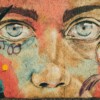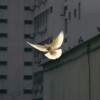Click here to listen to the episode on Spotify
In the seventh episode of the third season of the “Saturdays at Seven” conversation series, Todd Ream talks with Makoto Fujimura, independent artist and author. Fujimura begins by sharing the commitments and qualities that define nihonga or slow art. He offers some insights concerning the origins of such an artistic movement, what drew him to it, and what he thinks it offers to members of contemporary generations who encounter it. Fujimura then talks about his own calling as an artist, the way his liberal arts education at Bucknell University shaped it, the way advanced study at Tokyo University of the Arts gave it expression, and the way the practice of deep listening allowed him to make his own respectful contribution to nihonga. While practices such as painting and writing may appear disparate to most people, Fujimura then explains the deep and essentially inextricable relationship they share for him. His most recent book, Art Is, part memoir and part artistic philosophy, is a testament to that relationship. Fujimura closes by discussing the contribution the Church and the arts can make to one another and how the works he prepares and offers to the world serve as a means to doing so.
Todd Ream: Welcome to Saturdays at Seven, Christian Scholar’s Review’s conversation series with thought leaders about the academic vocation and the relationship that vocation shares with the Church. My name is Todd Ream. I have the privilege of serving as the publisher for Christian Scholar’s Review and as the host for Saturdays at Seven. I also have the privilege of serving on the faculty and the administration at Indiana Wesleyan University.
—
Our guest is Makoto Fujimura, independent artist and author. Thank you for joining us.
Makoto Fujimura: It’s great to be here. Thank you for having me.
Todd Ream: In 2019, the New York Times columnist David Brooks referred to your work as quote, “A small rebellion against the quickening of time,” end quote. In other places your work is referred to in Japanese as nihonga or in English, as slow art.
Would you begin by walking us back to the 19th century origins of nihonga? What brought it into existence and against what pressures it might have been working?
Makoto Fujimura: Yeah. Thank you.
First of all for that question, nihonga is a term that was coined in 19th century, but it hearkens back way before that when Japan became it, you know, I have, have its own unique identity as a culture, I would say about eighth century and the materials used minerals and basic materials, that is at the time, shares in common with medieval, let’s say manuscripts gold, silver malachite, azurite, lapis, and jewels as well as calligraphy ink, oyster shell usually on paper or silk. Nihonga, commonly known is mostly known in Japan as salon art. There are nihonga salons that you belong to, and they’re very much supported by the nation and so forth.
But I tend to be more on the contemporary art side, so I use nihonga materials to do new things. But the reason why I insist on slowing down and using minerals, pulverized minerals, and I mix them by hand here in my studio in Princeton is that the process of art to me has always been meditative. It is, definitely, the sacred process of praying and to discovering, being aware of what is happening in front of me.
Certainly, people think of representational art versus abstract art. But I do not see my art really in either category. It’s about re-presenting the invisible, indivisible. So that’s the process that I draw upon to slow down and to really pay attention to what is happening in front of me, what is happening around me, but also what is happening inside of me.
Todd Ream: Thank you. That process then calls forth from the artist, from you that experience. What then do you hope your art is designed to call forth from those who encounter it?
Makoto Fujimura: Yeah, that’s a great question. And, and for me, art is really a way creating a portal for people to walk into. And each person has a unique journey and unique way of moving into a work of art. And my job is to make it generative as possible and to hopefully it will be intriguing enough for even those who may not share the same faiths with me or the worldview, would feel invited into, right.
Art is hospitality in that sense that to create a portal for anyone to be able to stand under something more transcendent and therefore more beautiful. And so for me, it’s an exercise also in humility. I try to do work you know, not necessarily in the marketplace, let’s say. My art is really designed to be a gift to the world.
And I obviously work with galleries and, you know, the transactive market as, as well. But that’s not the reason why I paint. I paint to create meaning, to help people find whatever it is that they have the language to bring into a work of art. And it is like listening to a conversation and hopefully that conversation asks deeper and deeper questions.
Todd Ream: Thank you. From the perspective of the artist then, the one who creates, can you walk us through this process, perhaps for example, a painting, so from instruction to completion? Where does the idea come? How do you select the materials? How do you arrange them in relationship with one another and know when it’s done?
Makoto Fujimura: Yeah, so typical question, right? I get asked this a lot. Like how long does it take you to do your work? And, you know, it takes a lifetime. It takes a lifetime of trying to paint and failing a lot. And then you get to a point where you are able to find your voice in the very limitations that you have. Actually it’s a process of distilling who you are and what you are called to do. And so that takes a while.
And you know, I’m at a stage I suppose where I know my limits and, and, and yet I’m always endeavoring to break beyond them. And that’s the challenge of being an artist is, you know, you’re not just doing the same work over and over repetitively. And in an repetitively in an industrial sense. You’re always generating something new into the world, hopefully. So you are always taking risks.
Materials are fundamental to that discovery. That’s why I use very imperfect, polarized minerals rather than industrial materials, let’s say, that are designed to be accurate and exact. Mine takes advantage of the imperfections or thrives off of that. And so, the process is very slow.
You know, even if I’m traveling, let’s say, or away from the studio, I’m always painting in my head. That’s always the case. And my writing flows right out of my studio flow out of my work. So I don’t consider them to be separate at all. They’re, they’re part of what I do, even my travels, my journeys, you know, if I am, you know, lecturing about this book. It will be really straight out of studio experience. And it’s, again, slowing down, paying attention to what is around me, always being surprised by what the world brings.
You know, Calvin Seerveld, who just passed away, but he said there are burning bushes everywhere. We just stopped taking our shoes off, you know, and artists are the ones that I think intentionally keeping their shoes on and, and, and standing in front of this enigmatic mystery in front of us all the time, stopping to see smell, touch, and then we hopefully create something out of it that helps others to do the same.
So when you walk into my studio, you see so many different types of minerals and materials. And I am constantly communicating with, you know, nihonga is an ecosystem. It’s not just a technique and materials. It’s ecosystem of families, generations of paper makers brush makers, people who prepare pigments for a certain grade and certain purpose. And so you’re working with them constantly to gauge what you want to create into the world.
And so I talk about that a little bit in the book is a Journey into the Light book, as a way to describe what happens when I’m walking into a studio. But it opens up to this journey into Japanese culture and Korean culture and Asian cultures that really allow us a glimpse into this generational stewardship of beauty integrating nature with beauty and bringing out something in the world that is hopefully enduring out of these very ephemeral experiences.
Todd Ream: Thank you. In addition to being referenced as being representative of expressionism, your art, slow art, nihonga is often referred to as creation care.
In what ways are the materials and the way you work with them in terms of the art you offer the world, in what way is that an expression of creation care?
Makoto Fujimura: Yeah it is. And, you know, caring for your environment, caring for culture, you know, I coined the term culture care because I saw partly that creation care is impossible without culture care. What I mean by that is culture care is all about languages being cared for, how we speak, how we talk about issues. You know, we can be politically divided, but we need to find common ground to be able to speak to one another. And, in our divided, polarized times, it’s really you know, really a matter of our own survival to be able to do that.
And art brings in that language of mediation and, and even peacemaking. And so when we find ourselves divided, and even in some sense alienated from nature that everything about our relationship with natural world has become this, you know, polarized reality. We need to find new ways of understanding what nature is. And by the way, that is really connected with who we are as humans, what is a human that is a key question today and especially in light of technology.
And so this question of integration on nature and humanity, which is culture, culture is exactly that, but we have divorced culture from, in an industrial sense. We made it into utility and pragmatism and that creates this way of dehumanizing us ultimately. And so the reason why we’re struggling to be a steward of the environment or nature is because we are alienated from the humanity in us.
And that’s where art comes in. That’s where artists are so good at, instinctively and intuitively, they may not even realize they’re doing it, but they’re integrating the divided, fragmented reality into something beautiful. And they are not the ones to create ideological framework for that. But they are intuiting a lot of different polarized realities, fragmented realities and pulverized realities, and they’re creating something beautiful out of that.
Todd Ream: Thank you. I want to ask you now about your calling to art and how that came about? You earned an undergraduate degree from Bucknell University, double majoring in animal behavior and art. I like that. We’ll come back to animal behavior in a second. And minoring in creative writing. At what point though, did you discover art would play a considerable role in how you understood yourself and your vocation?
Makoto Fujimura: Yeah. Thanks. Thanks for asking that. It was my freshman year. First year. First year, you know, one of the great things about liberal arts education is that you, you are able to push yourself and ask deeper questions about yourself, your identity, what you are made to do, you know, as opposed to getting a skill and, and then, applying that to a job which is not unimportant, but it is one of the great gifts that I received in liberal arts education is to be able to search for, try out things and, you know, first see what you are not good at.
And, you know, growing up in a family of my father was a brilliant scientist and I just assumed that I would go into the sciences and, you know, I was intrigued by this interdisciplinary study of animal behavior, which is a lot of things combined psychology and biology and even environmental sciences, ecology. And, and so I was more interested in the interdisciplinary nature of that than perhaps the science, you know, the rigor of science itself.
And I discovered very quickly that, you know, what I’m interested in is, is the thought behind the thought. They are, you know, thought behind why these things exist. Why are we interested in animals or plants or the sky or you know, the universe? And, so I began to read literature, and I began to do what I do today, which is paint and, and write out of that experience. And I couldn’t write then. So it took several very good professors who took time to help me to understand what, what the discipline of writing meant. And to be able to harness that.
You know, today I have authored five books and back then if you, you know, if you told me that would be the case, I would not have believed you. Writing was one of the hardest things that I thought I was encountering in college. And it has given me a gift of discipline to be able to sit down and write, you know, every week, no matter what the topic was, that it was important to write things down.
And, and so that kind of led into what I know, but as I spend a lot of time and, and I was fortunate to, you know, even complete my degree in sciences as well as art and a place like Bucknell allows you to do that. And I am, to this day, grateful for that because that, you know, super integration has continued to be in my life.
You know, I am painting in here, but I am fascinated with monarch butterflies that are, you know, flying right now in Fuji Farm here in Princeton. And because I planted milkweed, they’re coming in now, in abundance and they’re laying eggs and, you know, and these things fascinate me. That again, nature and culture are connected. And we get to, as human beings see, harness the generative reality of nature into this struggle to create the future, which is what art is.
And that allows us to bring the invisible, intervisible spheres. So it is, you know, what I call faith’s journey, which is really seeing the value in the mystery of what you see, a mystery of what you don’t see. And artists are trying to do both. And these thoughts are not alien to scientific, you know, discoveries. Both sides share in that. And as I discovered with my father and so many, you know, great friends who are scientists, engineers, these are of the things that I’ve discovered along the way.
But I knew that when I articulated that I should try to make, you know, be full-time as an artist, I didn’t know what that meant. I didn’t know if you, I can even do that, but when I felt like that was in a sense, know, I could not, not do that. You know, there, there, it just, this is something that I must do and, you know, whatever outcome, ways of making that work would be secondary to that call that I felt I had.
And I used that word calling very early on, even though I was not a Christian at the time, I didn’t know who was calling me. But I discovered that, you know, indeed there was a voice that spoke to my heart very early on as a child painting something, and I felt this flow, you know, go, energy goes through me. And I didn’t know what that was. I thought everybody had that experience. So, you know I found out that you don’t talk about these things in middle school or people, people make fun of you.
But, you know, I really had this visceral experience that just connected with the visual and especially seeking beauty, was, was just something that I did every day even as a child. So I think that became very obvious to me the first year of college.
Todd Ream: Thank you. You then traveled to Japan and earned a master’s in art from Tokyo University of the Arts, which then also offered you the opportunity to stay and earn a doctorate.
In what ways did traveling to Japan also prove formative in terms of your vocation as an artist?
Makoto Fujimura: Yeah, I was born in Boston. My father was doing his postdoc research. And so I chose American citizenship as a teenager, but I decided to go back to Japan because every time I painted, there was a sense of this longing for my roots that I couldn’t reconcile. So I was able to fortunately get a national scholarship to study in Japan for a year and a half initially, and placed in this very prestigious program.
Tokyo University of Art that allow me to really study what I wanted to see was, especially 15th through 17th century art that Japanese art that, you know, I had access to museums around Tokyo. And anywhere that I wanted to see these works they will allow me to go in and examine them firsthand. And so, you know, after a year and a half, they invited me to apply for MFA program there and I accepted the Japanese government was paying for that. So it was a no brainer really at the time.
And then I was then invited into this really once in a lifetime opportunity to study with a master two masters. But nihonga masters who were some of the best artists of the time. And, and I am to this day, the only outsider, the only foreigner, that was allowed into this NEH program.
So I was able to spend six and a half years in Japan and, and that formed definitely something, awakened in me when, when I encountered these materials, nihonga materials, it, it really was like a glove fitting your hand perfectly because I walked into these nihonga shops in Tokyo and I described this in my book, this experience of seeing jars of beautiful minerals lined up. You know, the beauty flowing through the centuries of Japanese culture.
And when I got them to use as a student, my professor said, well, you really have to work with the best materials to understand how to use them. And so that meant not eating lunch, you know, and I, that I can’t afford these expensive azurite. But I did that and I had since then committed to use only the best. And later on when I was reading the Bible, I realized that’s what artisans in the Bible did too. It’s an offering, so you have to use the best materials.
So I continued that discipline. And so I found out very quickly that these materials suited my temperament as if I was born into them. And so I very quickly master technique, difficult techniques that would take normal students, you know, four years to master. I was able to figure it out in six months. So I knew I was, my temperament was suited for this, and, and, but the question is how, what, what kind of expression would I produce? Because nihonga can be very, very much tied to tradition in a way in terms of motifs and themes.
And I think what I brought into that genre was some, something as an outsider, um fresh way of honoring the tradition and then creating a something that will be universally relevant. So that meant that I, you know, I would go back to New York or New Jersey, New York area to exhibit in New York City and, and there’ll be a natural overlap between what I was showing as, as you noted, abstract expressionist tradition and, and nihonga as well.
Todd Ream: Thank you. This approach to art as you described and the way it sort of took hold in your life, I realize this is somewhat of an unfair question, but I’m gonna ask it anyway, is there a painting that comes to mind that is sort of more representative of this way approaching your work than perhaps others? And, and if so, could you describe it? I realize this is asking, like asking someone which one is the favorite of your children?
Makoto Fujimura: Right. But, well, yeah. But in terms of representing the culture, you know, I mean, all of my works try to do that. I have this working behind me. I don’t know if you can see it, this gold work, which I just pulled and you know, the, the way that this particular way of gilding gold works, came directly from my master that I learned under Matazō Kayama, who is, is arguably the best 20th century artist that Japan had.
He grew up in Kyoto, in a family that designed kimono patterns. And, and he, he had this understanding of gold. Gold it’s gilded in sheets and their microscopically thin, so it’s meticulously difficult to work with. Good gold you can literally see through. So he is teaching us a technique of how to gild this gold in different ways and I am modifying what he taught me then taught all of us then here.
But it was his kind of language of talking about gold that affected me deeply, which, was not just this kind of dedication and discipline to the craft, but his love for it, that how, how important gold is in Japanese tradition. And, and his history of painting is when Japan was coming out of war and they had nothing to eat, he realized that’s when he has to paint with gold. You know, so it’s this scarcity that was bleakness, black, dark, and full of ashes he saw all around him. He said, art has to transcend this somehow.
And so his effort to bring back 17th century bunjinga tradition, what’s known as bunjinga tradition, which is gorgeous using gold and silver and, and, and precious minerals into 20th century is the work that I’m carrying through to, to our time. And being living and working in ground zero, New York City for a long time, I came, you know, face-to-face with that reality. And, you know, I had to invoke him, you know, to say, well, I’m continuing your work to create beauty into this wasteland, darkness, brokenness, ground zero experience.
And that has caused me to see that, you know, the materiality of the Japanese past is not just so that it looks beautiful and extravagant and it catches your eye. But there’s a deeper sense of this insistence, this dedication to life that flows into these beautiful works. And to this day, I see that in the works of, especially in 16th and 17th century works, which was the time of feudal wars so very violent, very bleak time in Japanese history.
Todd Ream: Thank you. I want to transition now to asking you more formally about your writing. You’ve mentioned some of it already in particular your new book, newest book, Art Is but you mention on at least one occasion that you also write books between paintings. You spend a lot of time writing and, and spend a lot of time painting, so.
Makoto Fujimura: There’s a lot of time in between, right? But this started started at Bucknell, you know, I would be sitting there I had to write to pass. But then it became a discipline that never left me. You know, after Bucknell, I was in Connecticut for a short time, and then I was trying to paint and then I was working at a special education school.
But, you know, as I am painting, I am reflecting on thoughts and things that I have encountered and I had to process them somehow. And, and so I write essays you know, but that I never thought I would publish them. But I would just work on few things.
And then, after 9/11, I had this opportunity to help U.S. government and being on the National Council on the Arts to help our arts organizations. And so I would be waiting at the airport a lot and, you know, I would be writing just, just naturally thinking about what I would say to encourage these leaders and artists and people that I will meet. But, but, and that became my first book, you know, and, so, I think just writing has become part of me. But it was, I would say it was one of the hardest disciplines to learn to, to harness and, and I’m grateful for that.
Todd Ream: Art Is, is arguably equal parts memoir and artistic philosophy.
Makoto Fujimura: Yeah.
Todd Ream: Which when mixed together yield what is also a wonderfully illustrated book.
If I may, did you learn anything more about yourself and about your calling as an artist, as a result of writing this book, especially the memoir side of it? Are there things that came forward that perhaps you didn’t anticipate when you began the project?
Makoto Fujimura: No I didn’t. And, and thank you for pointing that out. My editor, Jennifer Banks at Yale Press who published my earlier book, Art and Faith: A Theology of Making book, and I was thinking, well, I would write an another book based on that theme. And it was during the pandemic, as the pandemic was waning, you know, she said, you know, I actually, I would love to have you write about what you see.
You know, and I thought about that. I said, well, I do see a lot, but you know, at the time I wasn’t sure if that will be, or could be or should be a book, you know? So I wrote the first couple paragraphs, which is basically this 25-meter walk from my house to my studio. And it’s literally this short walk. And I, I came into the studio one day during the shutdown, and I wrote a paragraph.
And then I realized, oh boy, I carry in so much by the time I enter into the studio, my sense is awakened by what I see. I’m hearing things, I am feeling things, and that all comes with me, you know, and the first joke that I make is all part of that. And, and so that paragraph became, you know, um a chapter and the chapter became a book.
And so it was, as you know, there was a discovery process for me of finding words and observations that, you know, I take care to expound upon has a life of its own. Just like my paintings, I really rely on what is already there to guide me. And so it became this very much a journey. Journey into the Light is the subtitle, but this journey into something mysterious and abounding and something that really, sheds light into my own heart.
Todd Ream: As with your painting, what do you hope people who, and again, I strongly encourage them to do so, who read this book? What do you hope they encounter when they read it?
Makoto Fujimura: I have found that, and this took me a while to realize this, that what I see actually is helpful for people. You know, it’s not just for my own.
I, I’m completely surprised until I wrote this, until I wrote this book, I really didn’t believe it. And, and, and I remember people like asking me. You know, like there’s, there’s something really wonderful about how you see the world. Can you describe it? Or something like that. I don’t know. I’m like, doesn’t everybody, you know? And then I realized that no, there’s a responsibility to this, you know.
And I have to help in some way articulate this because we are so divided in this culture. It’s black and white and we create false binaries all the time. So it’s easy to sell things. It’s easy to market things. It’s easy to make the news. The more shocking it is, the better. And we lost this capacity to see nuances and complexity without reducing them which is so important, right?
If you imagine a dish, a recipe made in that way, like totally just false binaries, and like we would taste it when we say, oh, it’s too salty, you know, or not enough salt, but that’s it. We lose all of the other flavors, you know, the color, the reality, and we don’t think that’s good.
But in the public discourse today, even in our Thanksgiving dinner conversations, we don’t know how to do that. And, you know, to accept that the world is complex and messy sometimes, but it’s can be also beautifully messy, that artists, you know, if you listen to jazz, you see so many musicians on stage who share very little with each other. You know, like they’re, they’re not like, they’re, they literally don’t have the same sound, you know? Not the same instruments.
Even backgrounds are different, right? You may have a Japanese guy playing with an African-American guy playing with a Polish guy, you know? And, and we are fascinated by that, right? And we see goodness in that, but we don’t see it in public discourse, in, in generally.
So, so when, when I articulate what I see complexity and beauty and chaos that is full of energy that can lead into, harnessed into something expansive. You know that’s what an artist is trained to do, then I realized, oh, so that may be an antidote to this cultural war polarity. You know, a world in which we lost, our hearts have grown cold, and, and we do not know, you know, who’s going to speak into this world in ways that actually helps people to live fully as humans and to be able to communicate with the other, that may be different or even opposite of what we believe.
That that is the challenge of this day, so I began to take that as a kind of an open challenge to myself, to be able to talk about it. And Art Is as a book moves from the personal to more public realities that literally pragmatic ways that we can help to see the world, in its full complexity and appreciate them.
Todd Ream: Whether as an artist or through painting or as an artist through writing, calling forth this sense of understanding of the world then, what virtues do you believe are most important to cultivate, and perhaps also what vices are most important to be aware of and perhaps confront?
Makoto Fujimura: Yeah, so, art is all about listening. Even what I do as a visual artist, I am listening to the flow. I’m listening to the colors. I hear things. And I think we need to be able to listen to each other, before we stake our positions and argue for the right certain positions.
You know, there’s great mystery in what is human and great mystery in the world, nature in the skies. And again, we do not take our shoes off to slow down and appreciate them. And I think we have lost that sense of wonderment and, and mystery that is at the heart of the universe actually. But we lost because we lost sight of that and playfulness that we need to discover anything. You ask the best scientist that, that’s what they’ll tell you is that, you know, it’s taking out on a walk with a friend that suddenly trigger that great thought or, you know, just being able to see this wonderment in the skies.
And, and so I think that is a critical task for humanity to rediscover especially for younger generation who inherited this anxiousness of this culture. We need to release ourselves from this forced binaries and technology that forces you to take a side, and be able to walk in a field and, and discover something entirely new that you never thought existed. And so, I say listening is probably the greatest reality that we are missing today.
Todd Ream: As we close, I want to ask you then, in what ways can artists be of greater service to the Church and in what ways can the Church also be of greater service to artists?
Makoto Fujimura: Yeah, so the Church is the artwork of God, right? Ephesians 2:8-10, for God, by grace we have been saved. It’s not of yourselves so no one may boast and we are God’s workmanship. That is an industrial translation of the word poiema, so we are God’s poems. We’re God’s masterpieces created in Christ Jesus to do good, good works or hard works, ergone.
And so if God is the artist, and I make this case in my previous book, is God is the only artist, real true artist who creates ex nihilo in love, pure love. None of us can do that unfortunately. But we are prone to create idols all the time, but if we attune our hearts and listen to the Spirit, we can create something because of God’s invitation to create into the new something that is enduring, something that lasts beyond what the capacity of this side of eternity can hold.
And so that invitation is a remarkable promise to this world, that the Church can harness and bring together a community of people who disagree with each other or who may, you know, have complete different histories as a background to come together in fellowship and break bread.
And that is, I think, the greatest gift that is so winsome that if we are able to do that, to be a child of God under the table of Christ’s sacrifice, right? To be able to together create something new into the world, so that we are all makers in that sense, that the Church becomes the most creatively abundant space that is known in your neighborhood, then we don’t need to share Christ, you know, because people will just come to us.
And I’ve seen this happen over and over in different communities and small samples where if we are simply be able to share our brokenness together as brothers and sisters in Christ, to be able to open ourselves to the vulnerabilities and challenges of our day, honestly, without wearing masks with, you know, and, and be able to share that grace has met me this day, and I am here not because of myself, you know, but because God has instilled in me this desire to be part of a community that is bigger than myself—community that is beautiful, beautifully broken, beautifully complex—then I think the world is gonna look at that and say, what, what an enigmatic burning bush. I can’t figure you guys out. You’re not this, you know this, you’re not that.
No, we are all of the body of Christ, right? And, and, and yes, broken, and yes, we go through terrible pains, but our Lord has guided us with Jesus’s wounds, right? Still visible, that we are able to find healing in. And so that reality, the Church as an artwork of God is the most potent antidote to everything you think of, war, you know, poverty, injustices of the world. That’s the answer that Jesus is giving us.
So, to me as an artist, I want to create works that point to that reality and to really reveal things that, you know, create this unveiling of the reality of God in front of us. But also as an artist, you know, I want to bring justice into the world because justice is a flip side of the same coin of beauty. And we, you know, we wanna do what we can through our work to create a portal for people to be able to integrate those two together, beauty and justice.
And then the Church is a place where, you know, every single member, every single part of the community, can celebrate that together to, you know, have, as Richard Foster said, discipline, you know, celebration or discipline. Discipline that leads into celebration of common communion.
Todd Ream: Wonderful. Thank you very much.
Our guest has been Makoto Fujimura, independent artist and author. Thank you for taking the time to share your insights and wisdom with us.
—
Thank you for joining us for Saturdays at Seven, Christian Scholar’s Review’s conversation series with thought leaders about the academic vocation and the relationship that vocation shares with the Church. We invite you to join us again next week for Saturdays at Seven.
























Nihonga— certainly a category he dominates, though himself not personally trying to overshadow anyone else. For me, his Silence and Beauty book was about as timely as any book (esp w the release of the movie Silence, of different origin). Great notes on the value of liberal arts. Also, interesting that writing is tough for him. Last week I observed a young artist in DC, Christian Pyle, paint for a crowd from Singapore in a rather unique style. It was by its form slow, but in a different way than Mako’s. Symmetrical but at first disconnected slashes of paint.